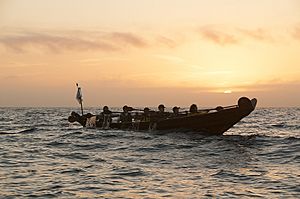Tomol facts for kids

A tomol (pronounced toe-mol) or tomolo is a special type of boat built by the Chumash people. The Tongva and Kizh people call their similar boats te'aat or ti'at. These boats are made from wooden planks. They have been used for a very long time in the areas around Santa Barbara and Los Angeles.
These plank boats were often used instead of or alongside older boats made from tule reeds. Tomols are usually between 10 and 30 feet long. They are about 3 to 4 feet wide. The Chumash people call the tomol the "House of the Sea." This name shows how much they trusted these boats on the water.
People use special double-bladed paddles, like those used for kayaks, to move the boat. Some experts think these boats might have first been built on Catalina Island. They could have been used for thousands of years. The tomol is known as one of the most advanced boats built in North America. It is also unique to the "New World" (the Americas).
Today, the Chumash, Tongva/Kizh, and Acjachemen people still build these amazing boats.
Contents
Building a Tomol
Tomols were often built using redwood trees. These trees would drift down the coast after storms. If redwood was hard to find, builders would use local pine wood.
To make the planks, crafters would split the wood using tools made from whalebone or deer antlers. They looked for straight pieces of wood without knots. Then, they would sand the wood smooth using sharkskin.
To join the planks, small holes were drilled. This allowed the planks to be tied together tightly. The gaps between the planks were then sealed with a special mixture called 'yop'. 'Yop' is made from hard tar and pine pitch that is melted and boiled.
A strong cross-plank was placed in the middle of the boat. This helped make the boat stronger and also served as a seat. After that, another layer of 'yop' was added to make the boat fully waterproof. Finally, the boat was painted with red ochre paint and then given a final protective layer. Sometimes, beautiful shell designs were added for decoration.
This way of building boats is special in the Americas. While some similar boats exist in other places, the tomol is truly unique. Building a tomol could take a skilled boatmaker up to 500 days! Paddlers use kayak-like paddles while crouching, not sitting, which makes the tomol very easy to steer.
The Tomol's Special Meaning
The tomol is more than just a boat; it has deep spiritual meaning for the Native American people. In 2018, Eva Pagaling, a member of the Santa Ynez Band of Samala Chumash Indians, described paddling a tomol. She said that "each pull of the oar is a prayer." She prayed for her loved ones and for strength and healing for everyone. She explained that her people are "water people" and that water holds a sacred power.
Cindi Alvitre (Tongva), who helped start the Ti'at Society, talked about the ti'at (tomol) in 2019. She called it "a vessel that allows humans to connect to the underworld." In the Native American worldview, there are three main parts of existence. The "underworld" is the watery place where ocean spirits live. The "middle world" is where humans live. The "upper world" is the space of ancestors and stars.
The ti'at acts like a special viewing spot. It's like floating above the ocean's depths while still feeling connected to the stars and the Milky Way.
History of the Tomol
Tomols were very important for trade between different Native American tribes. These tribes lived in areas that are now Point Conception, Santa Monica Bay, and the Channel Islands. There were special routes for trading. People used signal fires on land to help guide the boats. Much of the trade happened between what are now the large ports of Los Angeles and Long Beach. This journey usually took about one day of paddling.
The tomol was so important that it led to a new group in Chumash society. This group was called the 'Brotherhood of the Canoe'. They were in charge of building every new tomol. Their boat-building skills were passed down from older, experienced builders to their students. Only men from important families were allowed to own a tomol. Owners were sometimes identified by wearing grizzly or black bearskin. If cared for well, these boats could last for many decades. They were often passed down from one generation to the next.
By about 650 A.D., the tomol or te'aat was already very important to the Chumash and Tongva/Kizh people. In 1542, a Spanish explorer named Juan Rodriguez Cabrillo saw many tomols at a rich village. This place is now known as Malibu. Cabrillo called it pueblo de las canoas, meaning "town of canoes." Another explorer saw the brotherhood building boats in a different village. He named that village Carpinteria, which means "carpentry shop."
Some experts believe that the idea of sewn plank boats might have come from early Polynesian navigators. These navigators built similar boats and were known to have reached South America around the first millennium. Scholars have pointed out that some Native Californian boat words, like Chumashan tomol(o) and Gabrielino ti?at, might come from Polynesian languages. Many modern Chumash and Tongva/Kizh people say they have "always known" this connection. A short film in 2019 by KCET also explored this idea.
Parts of old tomols have been found in ancient trash piles (called middens) on the Channel Islands. Along with boat pieces, they found bones of dolphins, seals, and fish, as well as shells from abalone, clams, and limpets. Today, you can see reconstructed tomols built by modern Chumash people at museums. These include the Santa Barbara Museum of Natural History, the Santa Barbara Maritime Museum, and The Chumash Maritime Association of California.
Gallery
Resources
See also
 In Spanish: Tomol para niños
In Spanish: Tomol para niños



